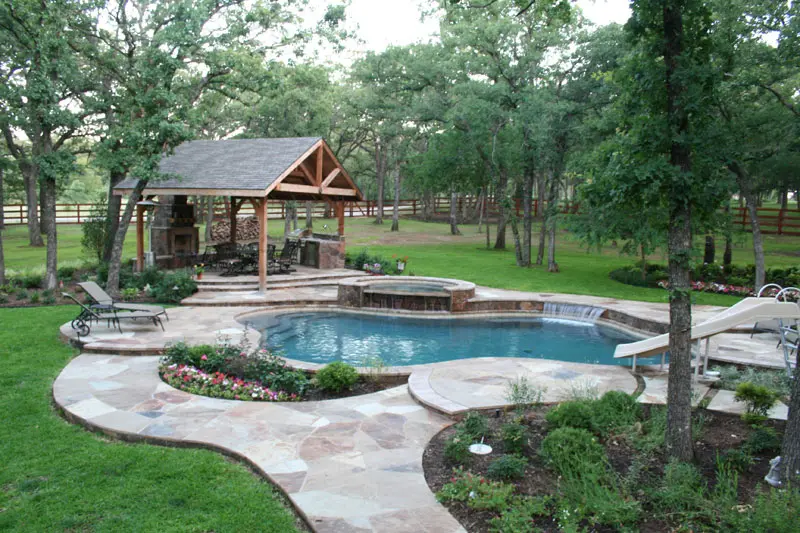61
Poolside Landscaping

Oftentimes the only difference between a swimming pool that looks good and one that looks great comes down to the landscaping.
Pool designers and landscape designers definitely agree on the importance of properly landscaping a pool area—it can really transform a backyard pool area. Oftentimes the only difference between a swimming pool that looks good and one that looks great comes down to the landscaping. As we enter the fall and a prime time to landscape (especially for trees & shrubs), now is a great time to plan and implement a landscaping plan. Following are some general tips and also plant selection tips to help you with your off-season landscaping plan.
Following are some thoughts to consider when planning your poolside landscaping:- Design lawns and flower beds so they slope away from the pool. If necessary, install a low, watertight edging or wall on the pool side of the lawn or planting area. This will help keep debris from entering the pool.
- Don’t plant trees too close to the pool. Trees provide a scenic background to any pool area, but a tree too close to a pool can result in a skimmer clogged with fallen leaves, leading to poor circulation and the growth of algae and bacteria. Also, some trees have root systems that can invade plumbing lines and damage the pool’s decking.
- Place plants in raised planters or moveable pots as opposed to directly adjacent to the pool in planter areas (deck leave-outs). Water run-off from plants can disturb the pool’s chemical balance.
- Try not to mow or water the lawn immediately before using the pool. Wet or loose grass clippings are easier for swimmers to track into the pool.
- Keep lawn and plant fertilizer out of the pool. Fertilizer will inhibit the ability of the chemical to treat the pool and can also stain the pool surface.
What plants are best for Denton area backyards?
There are many variables (amount of sun/shade, type of soil, amount of soil moisture, etc.) to consider when selecting plants, and it is always best to consult an expert for your particular situation. With that being said, following is what Ted Meador of Meador Nursery, who is a landscape designer with a horticulture degree from Texas A & M, recommends for the Denton area:
Annuals for sunny areas: Periwinkles, Zinnias, Portulaca, Angelonia, Ice Plant, Sweet Potato Vine, Tropical Hibiscus
Annuals for shady areas: Caladiums, Begonias, Coleus, Impatiens, Asparagus Fern
Perennials for sunny areas: Lantanas, Salvia Greggi, Katie’s Ruellia, Day Lilies, Canna, Banana Tree, Red Yucca
Perennials for shady areas: Wood Fern, Holly Fern, Ligularia, Hosta, Variegated Liriope
Groundcovers: Asian Jasmine, Liriope, Mondo Grass, Creeping Junipers, Purple Winter Creeper
Vines: Crossvine, Carolina Jessamine, Sweet Autumn Clematis, Coral Honeysuckle, Passion Vine
Shrubs for sunny areas: Dwarf Yaupon, Indian Hawthorn, Nandina (many varieties), Anthony Waterer Spirea, Dwarf Burford Holly
Shrubs for shady areas: Yewtopia, Acuba, Hydrangeas, Cast Iron Plant, American Beauty Berry
Ornamental Trees: Yaupon, Savannah Holly, Nellie R. Stevens Holly, Wax Myrtle, Eve’s Necklace (Crepe Myrtles are pretty but they shed an abundance of flowers in the pool)
Shade Trees: Chinese Pistache, Lacebark Elm, Cedar Elm, Burr Oak, Shumard Red Oak (Keep in mind that Oaks also produce lots of acorns along with leaves)
Ornamental Grasses: Maiden Grass, Gulf Muhly Grass, Little Kitten Grass, Blue Sedge, Hamlen Grass
Palms: Windmill Palm, Texas Sabal Palm
Plants that like wet areas: Horsetail Reed, Ruellia, Purple Loosestrife, Louisiana Iris (keep in mind that these plants are also invasive!)
By following these simple guidelines and plant choices, the chances of having problems with your pool and landscaping will be greatly reduced.
Matt has been around the pool business since he was born. When he graduated college in 1984, he joined the family business working for Gohlke Pool Supply. The following year Matt and his father formed a partnership, Gohlke Custom Pools, and started offering pool construction.





